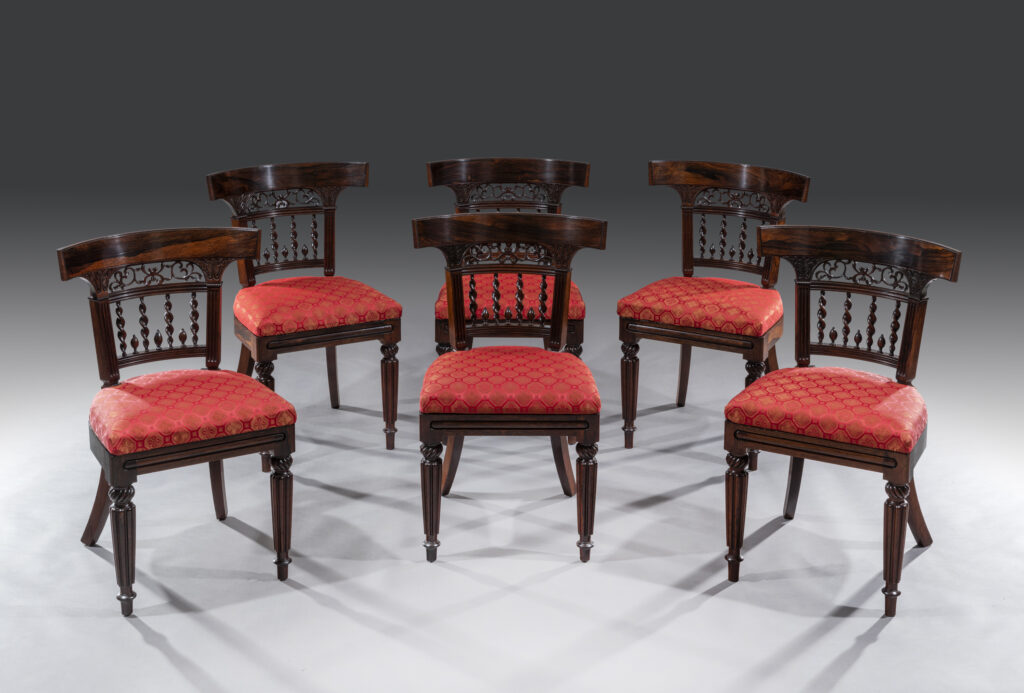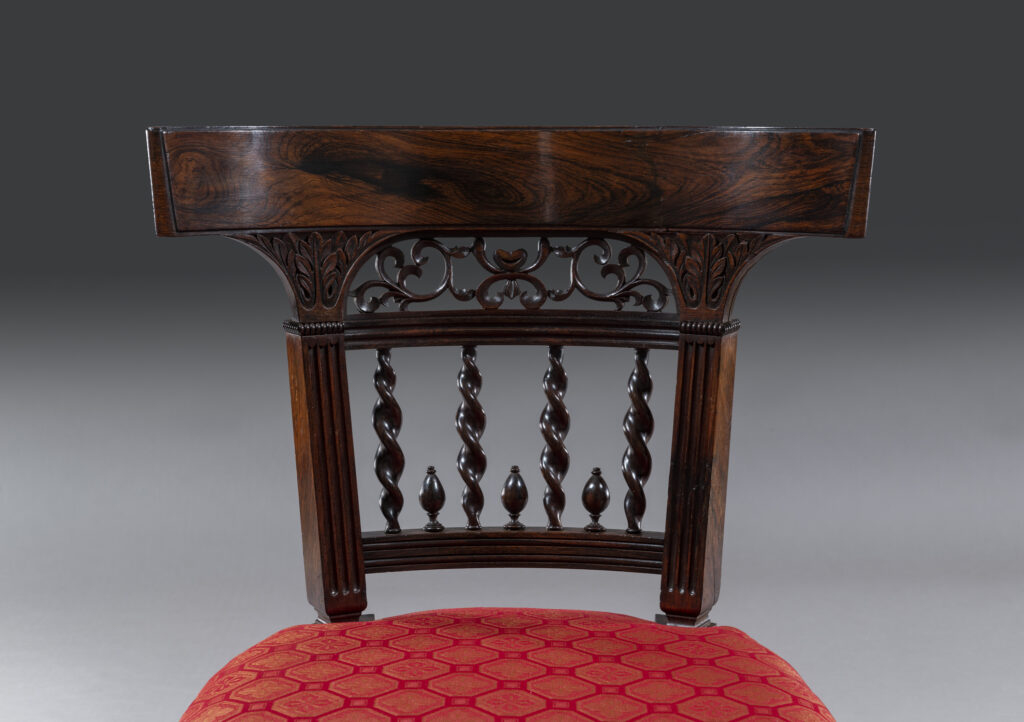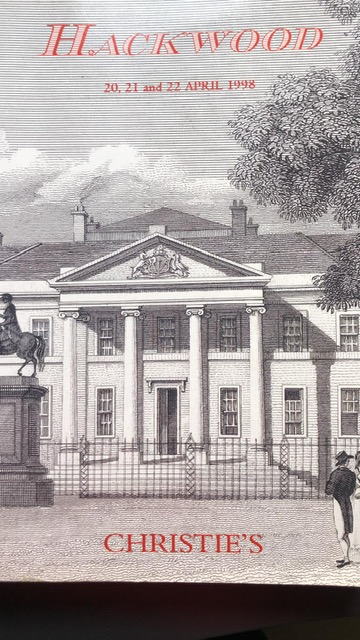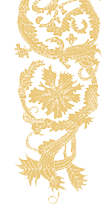Six Rosewood Gillow Dining Chairs



Six Rosewood Gillow Dining Chairs
English
circa 1815 - 1825
Unusual set of carved rosewood 19th century Regency period single dining chairs.
The highly figured concave back is over exaggerated in shape above crisply carved stiff leaf decorated capitols. The open fret carving rests on a reeded back rail above twisted solid rosewood vertical uprights and flanked by fluted rosewood supports.
The recently re-upholstered drop in seats have been recovered with a crimson and gold gothic pattern. The rosewood seat frame with an inset bar to the front.
The chair is raised on out-stretched back legs and 'Gillowesque' front legs. The turned knolled bun carvings above the tapered reeded legs stand on fine tapered feet.
The set of six chairs is very similar to a set of twenty four dining chairs made for Lord Bolton of Hackwood Park in 1813 by George and Richard Gillow of Oxford Street, illustrated in Susan E. Stuart's 'Gillows of Lancaster and London 1730-1840', 2008, P.219, pl.200 and sold at Christie's sale of the contents of Hackwood Park, 20-22nd April 1998, lot 158. Although the rails and legs have different carving the pierced backs are almost identical suggesting that the present chairs were either made by Gillows or they have been made to a Gillows' design.
Supplied to William, 2nd Baron Bolton (1782-1850) for Hackwood.
By descent until sold in 1935 with Hackwood to Wiliam Berry, 1st Viscount Camrose (d. 1954).
Thence by descent.
Literature
Gillows Memorandum, May 1813, The Dining Room: ’24 Handsome Mahogany Chairs’.
These dining-chairs are a most sophisticated and ornate version of one of a type of dining-chair that came to dominate Gillows production in the 1820s and 1830s. The evidence of the building of the dining-room at Hackwood suggests that these chairs were made in 1813 or shortly afterwards which is extremely early for such a highly ornamented design. In particular, the pierced toprail, almost colonial in inspiration, remained a very rare feature even later in the century when dining-chairs had become very ornate indeed.
Elements of the design can be found on a number of chairs from known Gillow commissions. The shape of the back and incised decoration appears on a set supplied to Belton House, Lincolnshire, in the mid-1820s and sold from there in Christie’s house sale, 30 April – 2 May 1984, lot 55, and subsequently resold more than once. Those chairs in their turn were derived from a pattern originally for the dining-room at Linton for Earl Cornwallis, dated 1825 (E102, City of Westminster Archive Centre). The Estimate Sketch Book for 1822-1830, p. 3285, includes a chair design for S.H. Stewart Esq. which incorporates the rare feature of the acroteria-headed front leg but with an ornately carved back (344/101).
THE HACKWOOD DINING-ROOM FURNITURE
One of the most dramatic additions that was made to Hackwood when the 2nd Lord Bolton radically altered the house after his marriage in 1810 was the huge shallow-domed dining-room thrown out to the west. The coffered ceiling was plastered in 1811-12 by Mr Coffee, an unidentified member of a Regency dynasty of journeymen sculptors and plasterers. The decoration of the dining-room itself is dominated by bands of corn and grape sprays in a row above the cornice. At some point it was decided to join the new dining-room to John Vardy’s drawing room which had previously been the west end of the house. The two rooms are divided by a screen of scagliola columns made by Joseph Alcott.
The dining-room must have been completed by mid-1813, a date suggested by two things. First is the dates on the four plaster statues by Humphrey Hopper that stand in the niches in Vardy’s former drawing room (lot 159). These were all manufactured between August and November 1813. The second and more complex issue is the furniture. The Memorandum that represents a provisional agreement between Gillows and Lord Bolton for the supply of furniture and which is dated May 1813 (Hampshire RO, Bolton Papers, 11M49/4681) lists the following furniture for the dining-room.
A Turkey Carpet
24 Handsome Mahogany Chairs
A Sett of Dining Tables to accommodate 30 persons
A Handsome Mahogany Cistern
A Capital Social Table
With the exception of the carpet, furniture that matches these descriptions was or is in the dining-room. However, they are not in the only surviving July 1813 invoice from Gillows to Lord Bolton, which includes only bedroom furniture. The dating of the dining-room furniture is thus a slight problem. According to standard notions of dating Regency furniture the heavier carving of the ornament, the dished shape of the padded dining-chair backs and their pierced toprails could not possibly date from before 1820. However, it seems impossible that Lord Bolton and his new heiress wife could go so far as to finish his dining-room in 1813 in the most fashionable style, including buying Hopper figures for the niches, and then leave the room naked of furniture for seven years. The most likely explanation is simply that the dining-room furniture at Hackwood does date from 1813 but that it is astonishingly avant-garde in taste.
Taken from the Christie's 'Hackwood' brochure - 20, 21 and 22 April 1998
Dimensions
Height 82.00 (Seat height 48.00)cm (32.28 inches)
Width 46.00cm (18.11 inches)
Depth 46.00cm (18.11 inches)
Stock No: 11291
Sold


